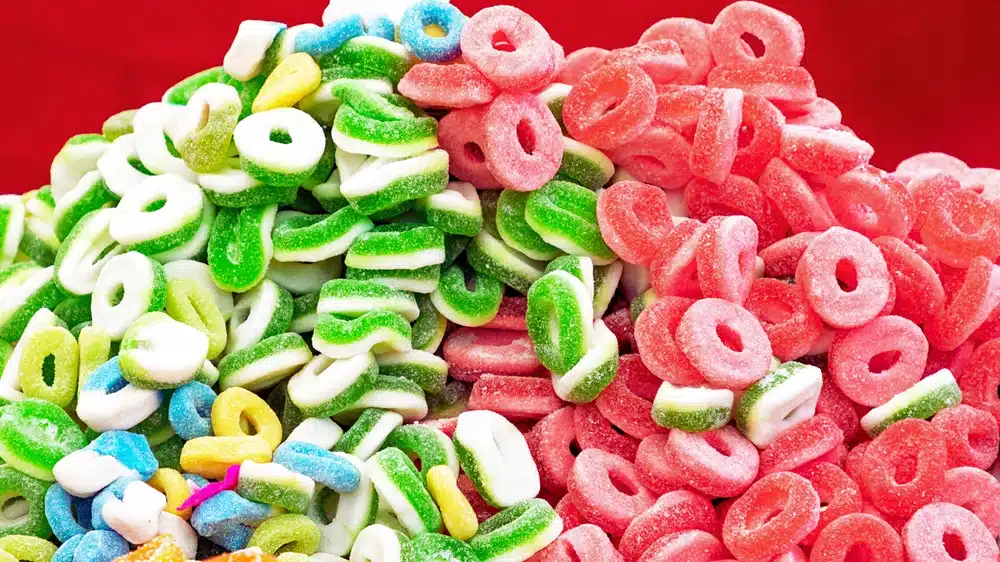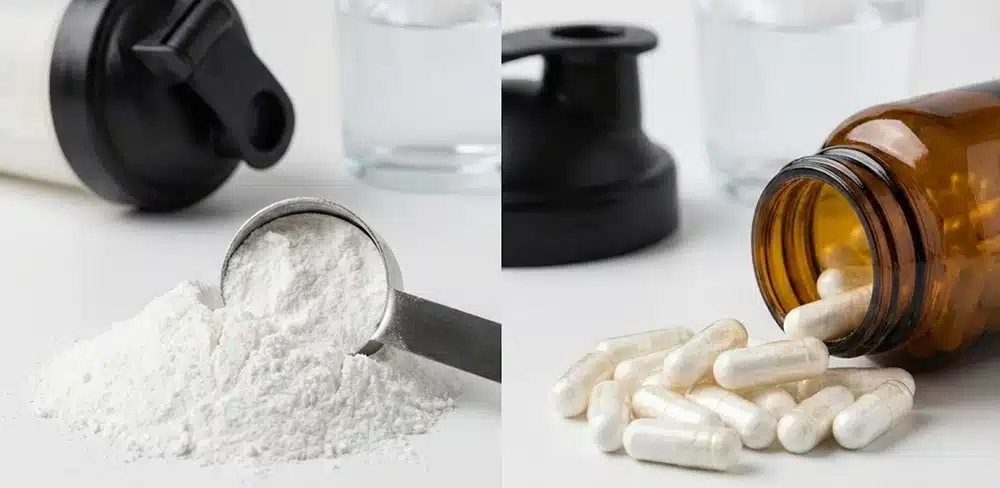Creatine gummies are the convenient, tasty new way to take the world’s most proven supplement, but are they as good as the old-school powder? This article cuts through the hype to settle the “creatine gummies vs powder” debate. We will give you a complete breakdown comparing them on the only factors that matter: effectiveness, dosage accuracy, cost, convenience, and the shocking results from recent lab tests. By the end, you’ll know exactly which one is truly better in 2025 and which one is right for your wallet and your fitness goals.

1. Effectiveness & Bioavailability
This is the most important question: do they work?
- The Theory (What Brands Claim):In a perfect world, yes. Creatine is creatine. If a gummy contains 5 grams of stable creatine monohydrate, your body should absorb it just as effectively as 5 grams of creatine from powder. The active ingredient is the same.
- The Reality (The Manufacturing Problem):creatine is notoriously unstable in certain environments. The gummy supplement manufacturing process to create a gummy involves three things creatine hates: acid, liquid, and heat.
When creatine is exposed to these conditions for too long, it begins to break down and degrade into creatinine, an inert (useless) waste-product that your body just excretes.
Recent Lab Tests
This isn’t just a theory; it’s now a documented “scandal.” In 2024 and 2025, several independent lab tests on popular, off-the-shelf creatine gummies have sent shockwaves through the supplement industry.
- A 2024 analysis by SuppCo, a supplement-tracking app, found that many gummy products had “vast inconsistencies” in their dosage.
- More shockingly, independent tests by NOW Foods found that over 40% of the creatine gummy products they tested contained less than 80% of the creatine claimed on the label. Some had almost none.
This means you could be buying a product that is fundamentally ineffective, right from the factory.
The Research Gap Want to find research on the benefits of creatine? You’ll find thousands of studies. But here’s the catch: all of that data—all those decades of proof—were established using creatine powder.
As of today, there is virtually no peer-reviewed scientific research that validates the effectiveness, stability, or bioavailability of creatine in a gummy form.
2. Creatine Gummies vs Powder:Cost Comparison
The difference in price point between raw creatine powder and a finished gummy product, especially from a reputable gummy supplement manufacturer is stark. If you were to get a quote from Gensei for both, you’d quickly see the disparity.
- Creatine Powder: Famously one of the most affordable and cost-effective supplements you can buy. A standard 5-gram serving often costs just a few cents. A whole year’s supply might cost you $70-$80.
- Creatine Gummies: You are paying a massive premium for convenience. Gummies can be anywhere from 2 to 8 times more expensive per serving than powder.

Worse yet, you typically need to eat 3-5 gummies just to get a single 5-gram serving, which compounds the cost. That $600+ yearly bill one report cited doesn’t sound so good, especially when you consider you’re potentially paying for something that doesn’t even contain the active ingredient.You’re paying up to 800% more for a product that recent tests show may not even contain the active ingredient you’re paying for.
3. Convenience & Taste
- Gummies: They are the definition of convenience. There’s no mixing, no mess, no shaker bottle to clean. You can throw them in your gym bag, take them on a plane, or keep them in your desk drawer. Plus, they taste great.
- Powder: This is the “hassle.” You have to scoop it, mix it, and deal with the sometimes gritty or chalky texture. It’s not as portable and can be messy.
There is a valid argument for “adherence.” The best supplement is the one you actually remember to take. If you truly hate the powder and always skip it, the sheer simplicity of a gummy might lead to more consistent use.
4. Dosage & Ingredients
Beyond the big issues of effectiveness and cost, it’s crucial to look at what’s actually on the supplement panel. This is where the differences between powder and gummies become even more stark, impacting both your results and your diet.
Dosage Flexibility and Accuracy
- Powder: Powder is the clear winner in control. It gives you precise, flexible dosing. You can easily measure a standard 5-gram scoop for your daily maintenance phase or adjust it to 10-20 grams if you’re doing a loading phase. What you scoop is what you get.
- Gummies: Gummies offer the opposite. They come in a fixed, low dose—typically just 1 to 1.5 grams of creatine per gummy. To get the scientifically-backed 5-gram daily dose, you’d have to eat a handful of 3 to 5 gummies. This is not only inefficient and expensive but also makes a loading phase impractical, as it would require eating 15-20 gummies per day.
Added Ingredients (The Hidden “Con” of Gummies)
This is the part most people overlook. To make a supplement taste like candy, you have to add candy. A gummy isn’t just creatine; it’s a delivery system packed with other ingredients.
A typical 5-gram equivalent serving of creatine gummies (3-5 gummies) can add:
- Sugar (sometimes 5-7+ grams)
- Artificial Sweeteners or Sugar Alcohols
- Gelatin (meaning most are not vegan)
- Fillers and Binders
A single 5-gram equivalent dose from gummies could add 30+ calories and a significant helping of sugar to your daily intake, which may be counterproductive to your health and fitness goals.
Purity
- Powder: A good creatine monohydrate powder is one of the purest supplements you can buy. The ingredient list is simple: 100% creatine monohydrate. It has no sugar, no fillers, no calories, and is vegan-friendly.
- Gummies: Are, by nature, a mix of many ingredients.
This table visually summarizes the actual differences between powder and chewing gum dosages:
| Feature | Creatine Powder | Creatine Gummies |
|---|---|---|
| Typical Serving Size | 1 scoop | 3-5 gummies |
| Creatine per Serving | ~5 grams | ~3-5 grams (total) |
| Dose Flexibility | High (Easy to adjust) | Low (Fixed per gummy) |
| Added Sugar per Serving | 0 grams | 5 – 7+ grams |
| Practical for Loading? | Yes (e.g., 4 scoops/day) | No (Would require 15-20 gummies/day) |
Pros and Cons: Creatine Gummies vs Powder
Creatine Gummies
- Pros:
- ✔️Unbeatable Convenience: They are portable, require no mixing, and are mess-free.
- ✔️Good Taste: They taste like candy, which makes them enjoyable to take.
- ✔️May Improve Consistency: Because they are so easy to take, you might be less likely to forget your daily dose.
- Cons:
- ❌Major Effectiveness & Reliability Issues: This is the biggest drawback. The article highlights lab tests showing over 40% of gummy brands are severely underdosed (containing less than 80% of the creatine claimed) or have none at all.
- ❌Manufacturing Instability: The gummy supplement manufacturing process (using heat, acid, and liquid) can destroy creatine and degrade it into creatinine, a useless waste product.
- ❌Extremely Expensive: They can be 2 to 8 times more expensive per serving than powder.
- ❌Poor Dosing: You need to eat a handful (3-5 gummies) just to get one 5-gram serving, making a “loading phase” impractical.
- ❌Added Ingredients: A single serving can be packed with 5-7+ grams of sugar, extra calories, fillers, and gelatin (which is not vegan).
Creatine Powder
- Pros:
- ✔️Proven Effective: Its benefits are backed by decades of scientific research.
- ✔️Reliable & Stable: What’s on the label is what’s in the tub. The powder is stable and doesn’t degrade like in gummies.
- ✔️Extremely Cost-Effective: It’s one of the cheapest supplements, costing just cents per serving.
- ✔️Pure: Typically 100% creatine monohydrate with no added sugar, calories, or fillers.
- ✔️Flexible Dosing: A scoop allows for precise 5-gram servings and makes a “loading phase” easy and practical.
- Cons:
- ❌Inconvenient: It’s a “hassle.” You have to scoop it and mix it with liquid, which can be messy.
- ❌Taste/Texture: Can be gritty or chalky, which some people dislike.
- ❌Less Portable: Carrying a tub of powder is not as easy as a small bottle of gummies.
The Final Verdict
| Feature | Creatine Powder | Creatine Gummies |
|---|---|---|
| Effectiveness & Bioavailability | WINNER | LOSER |
| Cost | WINNER | LOSER |
| Purity & Dosing Accuracy | WINNER | LOSER |
| Convenience & Taste | LOSER | WINNER |
You should buy creatine powder if: You are… well, almost everyone. If you are an athlete, bodybuilder, or casual gym-goer who wants a supplement that is proven to work, cost-effective, and reliable, powder is your only serious choice.
You might consider creatine gummies if:
- You are a person who values convenience above all other factors, including cost and proven efficacy.
- You are willing to pay an 8x premium for a product that has a high chance of being underdosed.
- You travel constantly and find it absolutely impossible to carry a small tub of powder.
Frequently Asked Questions (FAQ)
resource
- A February 29, 2024 article titled “NOW Reports Widespread Failings in Creatine Gummy Tests” details the findings. It states that NOW tested 12 creatine gummy brands and found a 46% failure rate (6 out of 12 brands failed to meet their label claim).(source link: https://www.nutraceuticalsworld.com/breaking-news/now-reports-widespread-failings-in-creatine-gummy-tests/)
- Creatine Gummies Or Creatine Powder, Which May Work Best for You?(source link: https://www.healthline.com/health/creatine-gummies-vs-powder)


